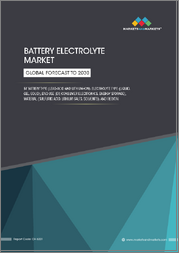
|
시장보고서
상품코드
1658023
아연 배터리용 전해액 시장 규모, 점유율, 성장 분석 : 유형별, 용도별, 지역별 - 산업 예측(2025-2032년)Zinc Battery Electrolyte Market Size, Share, and Growth Analysis, By Type (Alkaline Electrolytes, Acidic Electrolytes), By Application (Consumer Electronics, Automotive), By Region - Industry Forecast 2025-2032 |
||||||
아연 배터리용 전해액 시장 규모는 2023년 1억 520만 달러로 평가되며, 예측 기간(2025-2032년) 동안 14.4%의 CAGR로 2024년 1억 2,035만 달러에서 2032년 3억 5,306만 달러로 성장할 것으로 예상됩니다.
세계 아연 배터리용 전해액 시장은 그리드 규모의 에너지 저장, 전기자동차, 휴대용 전자기기 등 다양한 분야에서 아연 기반 배터리에 대한 수요 증가에 힘입어 성장하고 있습니다. 이러한 성장은 주로 재생에너지원의 추진으로 인해 효율적인 에너지 저장 솔루션에 대한 필요성이 증가하고 있기 때문입니다. 전기자동차의 보급이 확대되고 정전 시 백업 전원에 대한 수요가 증가함에 따라 시장 모멘텀에 더욱 기여하고 있습니다. 그러나 아연 배터리의 낮은 인지도, 대체 기술과의 경쟁, 높은 초기 제조 비용 등의 문제가 제약 요인으로 작용하고 있습니다. 그럼에도 불구하고, 성능과 효율을 향상시키기 위한 배합의 발전과 비용 절감 및 확장성 향상을 약속하는 혁신적인 제조 기술이 새로운 트렌드로 부상하고 있습니다.
목차
소개
- 조사 목적
- 조사 범위
- 정의
조사 방법
- 정보 조달
- 2차와 1차 데이터 방법
- 시장 규모 예측
- 시장 가정과 제한
주요 요약
- 세계 시장 전망
- 공급과 수요 동향 분석
- 부문별 기회 분석
시장 역학과 전망
- 시장 개요
- 시장 규모
- 시장 역학
- 성장 촉진요인과 기회
- 성장 억제요인과 과제
- Porters 분석
주요 시장 인사이트
- 핵심성공요인
- 경쟁 정도
- 주요 투자 기회
- 시장 생태계
- 시장 매력 지수(2024년)
- PESTEL 분석
- 거시경제 지표
- 밸류체인 분석
- 가격 분석
- 사례 연구
아연 배터리용 전해액 시장 규모 : 유형별 & CAGR(2025-2032년)
- 시장 개요
- 알칼리 전해질
- 산성 전해질
아연 배터리용 전해액 시장 규모 : 용도별 & CAGR(2025-2032년)
- 시장 개요
- 가전
- 자동차
- 전력 저장
- 기타
아연 배터리용 전해액 시장 규모 : 지역별 & CAGR(2025-2032년)
- 북미
- 미국
- 캐나다
- 유럽
- 독일
- 스페인
- 프랑스
- 영국
- 이탈리아
- 기타 유럽
- 아시아태평양
- 중국
- 인도
- 일본
- 한국
- 기타 아시아태평양
- 라틴아메리카
- 브라질
- 기타 라틴아메리카
- 중동 및 아프리카
- GCC 국가
- 남아프리카공화국
- 기타 중동 및 아프리카
경쟁 정보
- 상위 5개사의 비교
- 주요 기업의 시장 포지셔닝(2024년)
- 주요 시장 기업이 채용한 전략
- 최근의 시장 동향
- 기업의 시장 점유율 분석(2024년)
- 주요 기업 개요
- 기업 상세
- 제품 포트폴리오 분석
- 기업 부문별 점유율 분석
- 매출 전년비 비교(2022-2024년)
주요 기업 개요
- BASF SE(Germany)
- Targray Technology International Inc.(Canada)
- Henan Kelong New Energy Co., Ltd.(China)
- Phinergy(Israel)
- Umicore(Belgium)
- Jiangxi Sanchuan Jieneng Technology Co., Ltd.(China)
- EnergyX(US)
- Nano One Materials Corp.(Canada)
- Hunan Shanshan Advanced Material Co., Ltd.(China)
- Titanate Advanced Materials Corporation(Japan)
- Enirgi Power Storage(Australia)
- Ilika Plc(UK)
- ZAF Energy Systems Inc.(US)
- BioSolar Inc.(US)
- Zhejiang Long Time New Material Co., Ltd.(China)
- VSPC(Australia)
- ZincFive Inc.(US)
- Prieto Battery Inc.(US)
결론과 제안
ksm 25.03.26Zinc Battery Electrolyte Market size was valued at USD 105.2 million in 2023 and is poised to grow from USD 120.35 million in 2024 to USD 353.06 million by 2032, growing at a CAGR of 14.4% during the forecast period (2025-2032).
The Global Zinc Battery Electrolyte Market is expanding, fueled by a rising demand for zinc-based batteries across diverse sectors, including grid-scale energy storage, electric vehicles, and portable electronics. This growth is primarily driven by the push for renewable energy sources, propelling the need for efficient energy storage solutions. The increasing adoption of electric vehicles and a heightened demand for backup power during outages further contribute to market momentum. However, challenges such as limited awareness of zinc batteries, competition from alternative technologies, and high initial manufacturing costs pose constraints. Nonetheless, emerging trends reveal advancements in zinc battery electrolyte formulations aimed at enhancing performance and efficiency, alongside innovative manufacturing techniques that promise to lower costs and improve scalability.
Top-down and bottom-up approaches were used to estimate and validate the size of the Zinc Battery Electrolyte market and to estimate the size of various other dependent submarkets. The research methodology used to estimate the market size includes the following details: The key players in the market were identified through secondary research, and their market shares in the respective regions were determined through primary and secondary research. This entire procedure includes the study of the annual and financial reports of the top market players and extensive interviews for key insights from industry leaders such as CEOs, VPs, directors, and marketing executives. All percentage shares split, and breakdowns were determined using secondary sources and verified through Primary sources. All possible parameters that affect the markets covered in this research study have been accounted for, viewed in extensive detail, verified through primary research, and analyzed to get the final quantitative and qualitative data.
Zinc Battery Electrolyte Market Segments Analysis
Global Zinc Battery Electrolyte Market is segmented by Type, Application and region. Based on Type, the market is segmented into Alkaline Electrolytes and Acidic Electrolytes. Based on Application, the market is segmented into Consumer Electronics, Automotive, Power Storage and Others. Based on region, the market is segmented into North America, Europe, Asia Pacific, Latin America and Middle East & Africa.
Driver of the Zinc Battery Electrolyte Market
The increasing adoption of renewable energy sources like solar and wind power has created a significant demand for effective energy storage solutions. In this context, zinc batteries have proven to be a compelling technology for storing renewable energy efficiently. As the reliance on such sources continues to rise, the need for suitable zinc battery electrolytes becomes more pronounced. This trend is anticipated to fuel the growth of the zinc battery electrolyte market, as these electrolytes play a crucial role in enhancing the performance and efficiency of zinc battery systems, ultimately supporting the transition to sustainable energy storage solutions.
Restraints in the Zinc Battery Electrolyte Market
The adoption of zinc battery electrolytes may be hindered by their relatively high cost when compared to other battery technologies. This financial barrier can pose a challenge for potential users, as the expense involved in procuring these electrolytes might discourage investments and implementation in various applications. As industries and consumers continuously seek cost-effective energy storage solutions, the elevated pricing of zinc battery electrolytes may restrict their market penetration and limit their attractiveness against more economically viable alternatives. Thus, the high costs associated with these electrolytes represent a significant constraint in their wider acceptance and deployment in the energy sector.
Market Trends of the Zinc Battery Electrolyte Market
The Zinc Battery Electrolyte market is witnessing a significant upward trend driven by the heightened emphasis on sustainable battery technologies amid global environmental concerns. As industries and consumers alike prioritize eco-friendly solutions, zinc batteries have emerged as a favorable alternative due to their composition of abundant, recyclable materials. This shift towards sustainability not only enhances the appeal of zinc-based solutions but also aligns with regulatory pressures promoting greener energy storage options. Consequently, investments in zinc battery research and development are surging, positioning the Zinc Battery Electrolyte market for robust growth as manufacturers seek to capitalize on this eco-conscious consumer shift.
Table of Contents
Introduction
- Objectives of the Study
- Scope of the Report
- Definitions
Research Methodology
- Information Procurement
- Secondary & Primary Data Methods
- Market Size Estimation
- Market Assumptions & Limitations
Executive Summary
- Global Market Outlook
- Supply & Demand Trend Analysis
- Segmental Opportunity Analysis
Market Dynamics & Outlook
- Market Overview
- Market Size
- Market Dynamics
- Drivers & Opportunities
- Restraints & Challenges
- Porters Analysis
- Competitive rivalry
- Threat of substitute
- Bargaining power of buyers
- Threat of new entrants
- Bargaining power of suppliers
Key Market Insights
- Key Success Factors
- Degree of Competition
- Top Investment Pockets
- Market Ecosystem
- Market Attractiveness Index, 2024
- PESTEL Analysis
- Macro-Economic Indicators
- Value Chain Analysis
- Pricing Analysis
- Case Studies
Global Zinc Battery Electrolyte Market Size by Type & CAGR (2025-2032)
- Market Overview
- Alkaline Electrolytes
- Acidic Electrolytes
Global Zinc Battery Electrolyte Market Size by Application & CAGR (2025-2032)
- Market Overview
- Consumer Electronics
- Automotive
- Power Storage
- Others
Global Zinc Battery Electrolyte Market Size & CAGR (2025-2032)
- North America (Type, Application)
- US
- Canada
- Europe (Type, Application)
- Germany
- Spain
- France
- UK
- Italy
- Rest of Europe
- Asia Pacific (Type, Application)
- China
- India
- Japan
- South Korea
- Rest of Asia-Pacific
- Latin America (Type, Application)
- Brazil
- Rest of Latin America
- Middle East & Africa (Type, Application)
- GCC Countries
- South Africa
- Rest of Middle East & Africa
Competitive Intelligence
- Top 5 Player Comparison
- Market Positioning of Key Players, 2024
- Strategies Adopted by Key Market Players
- Recent Developments in the Market
- Company Market Share Analysis, 2024
- Company Profiles of All Key Players
- Company Details
- Product Portfolio Analysis
- Company's Segmental Share Analysis
- Revenue Y-O-Y Comparison (2022-2024)
Key Company Profiles
- BASF SE (Germany)
- Company Overview
- Business Segment Overview
- Financial Updates
- Key Developments
- Targray Technology International Inc. (Canada)
- Company Overview
- Business Segment Overview
- Financial Updates
- Key Developments
- Henan Kelong New Energy Co., Ltd. (China)
- Company Overview
- Business Segment Overview
- Financial Updates
- Key Developments
- Phinergy (Israel)
- Company Overview
- Business Segment Overview
- Financial Updates
- Key Developments
- Umicore (Belgium)
- Company Overview
- Business Segment Overview
- Financial Updates
- Key Developments
- Jiangxi Sanchuan Jieneng Technology Co., Ltd. (China)
- Company Overview
- Business Segment Overview
- Financial Updates
- Key Developments
- EnergyX (US)
- Company Overview
- Business Segment Overview
- Financial Updates
- Key Developments
- Nano One Materials Corp. (Canada)
- Company Overview
- Business Segment Overview
- Financial Updates
- Key Developments
- Hunan Shanshan Advanced Material Co., Ltd. (China)
- Company Overview
- Business Segment Overview
- Financial Updates
- Key Developments
- Titanate Advanced Materials Corporation (Japan)
- Company Overview
- Business Segment Overview
- Financial Updates
- Key Developments
- Enirgi Power Storage (Australia)
- Company Overview
- Business Segment Overview
- Financial Updates
- Key Developments
- Ilika Plc (UK)
- Company Overview
- Business Segment Overview
- Financial Updates
- Key Developments
- ZAF Energy Systems Inc. (US)
- Company Overview
- Business Segment Overview
- Financial Updates
- Key Developments
- BioSolar Inc. (US)
- Company Overview
- Business Segment Overview
- Financial Updates
- Key Developments
- Zhejiang Long Time New Material Co., Ltd. (China)
- Company Overview
- Business Segment Overview
- Financial Updates
- Key Developments
- VSPC (Australia)
- Company Overview
- Business Segment Overview
- Financial Updates
- Key Developments
- ZincFive Inc. (US)
- Company Overview
- Business Segment Overview
- Financial Updates
- Key Developments
- Prieto Battery Inc. (US)
- Company Overview
- Business Segment Overview
- Financial Updates
- Key Developments



















